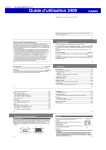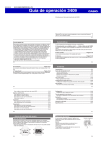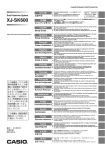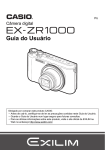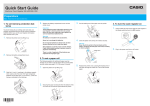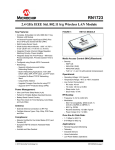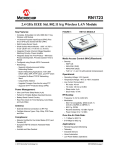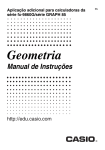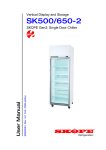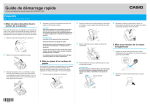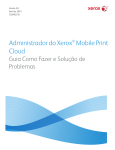Download YA-S10_UsersGuide_Portuguese - Support
Transcript
Caixa de Correção Geométrica P YA-S10 Guia do Usuário z Certifique-se de ler as precauções no Guia de Configuração da YA-S10 antes de usar a Caixa de Correção Geométrica e o seu Sistema de Projeção. z Realize os passos de configuração descritos no Guia de Configuração da YA-S10 antes de usar a Caixa de Correção Geométrica e o seu Sistema de Projeção. z Certifique-se de guardar toda a documentação do usuário à mão para futuras consultas. z Para obter a última versão deste manual, visite o site no endereço URL abaixo. http://world.casio.com/manual/projector/ z DLP é uma marca registrada da Texas Instruments dos Estados Unidos. z HDMI, o logotipo HDMI e High-Definition Multimedia Interface são marcas comerciais ou marcas registradas da HDMI Licensing, LLC. z XGA é uma marca registrada da IBM Corporation dos Estados Unidos. z Crestron é uma marca registrada da Crestron Electronics, Inc. dos Estados Unidos. z Todos os outros nomes de empresas e produtos mencionados aqui podem ser marcas registradas ou marcas comerciais dos seus respectivos proprietários. z Partes deste produto são baseadas parcialmente no trabalho do Independent JPEG Group. z O conteúdo deste Guia do Usuário está sujeito a modificações sem aviso prévio. z É proibido copiar este manual no todo ou em parte. Você está autorizado a usar este manual somente para o seu próprio uso pessoal. O uso para qualquer outro propósito é proibido sem a permissão da CASIO COMPUTER CO., LTD. z A CASIO COMPUTER CO., LTD. não assume nenhuma responsabilidade por quaisquer lucros perdidos ou reclamações de terceiros decorrentes do uso deste produto ou deste manual. z A CASIO COMPUTER CO., LTD. não assume nenhuma responsabilidade por quaisquer perdas ou lucros perdidos decorrentes da perda de dados devido a um mau funcionamento ou manutenção deste produto, ou por qualquer outro motivo. z As telas de amostra mostradas neste manual são apresentadas unicamente para propósitos ilustrativos, e podem não representar exatamente as telas reais produzidas pelo produto. 1 Sumário Operações na Caixa de Controle.................. 3 Uso de uma rede LAN com fio para controlar o Sistema de Projeção............. 11 Controle remoto da Caixa de Controle ............. 3 Teclas e indicador da Caixa de Controle .......... 3 Para mudar a fonte de entrada (INPUT) ............ 4 Ajuste automático de um sinal de entrada RGB (AUTO) ..................................... 4 Apagamento da imagem e silenciamento do áudio (BLANK) .......................................... 4 Congelamento de uma imagem (FREEZE)........ 4 Alteração da razão de aspecto da imagem da fonte de entrada (ASPECT)......... 5 Ajuste do nível do volume ................................. 6 Criação de um logotipo personalizado ............. 6 Dispositivos externos suportados ................... 11 Uso de um computador para configurar as definições de LAN da Caixa de Controle..... 11 Operação do Sistema de Projeção com comandos RS-232C .................................. 14 Formato de envio de comandos ..................... 14 Lista dos comandos ........................................ 15 Indicador ....................................................... 16 Localização e solução de problemas......... 17 Apêndice ....................................................... 18 Uso do menu de configuração ...................... 8 Sinais suportados............................................ 18 Operações básicas no menu de configuração .................................................. 8 Definições do menu de configuração ............... 8 Termos e convenções z O termo “Sistema de Projeção” neste manual refere-se aos sistemas listados abaixo. • Sistema de Projeção Dual XJ-SK600 • Sistema de Projeção Dual XJ-SK650 • Os sistemas de projeção são formados por uma Caixa de Correção Geométrica YA-S10 (denominada “Caixa de Controle” neste manual) conectada a um ou dois projetores CASIO disponíveis separadamente. z Use as teclas [S], [T], [W] e [X] do controle remoto (YT-200) da Caixa de Controle para selecionar os itens de definição em uma caixa de diálogo ou menu exibido na tela de projeção. Use estas teclas quando for instruído “selecione xxx” neste manual. Nota Alguns modelos cobertos neste manual podem não se encontrar disponíveis em certas áreas geográficas. 2 Operações na Caixa de Controle As operações na Caixa de Controle podem ser controladas com o seu controle remoto (YT-200) ou com as teclas na própria Caixa de Controle. O controle remoto da Caixa de Controle permite-lhe controlar o seu Sistema de Projeção exatamente como se fosse um único projetor. Controle remoto da Caixa de Controle A Caixa de Controle possui receptores de sinal na sua frente e traseira. Aponte o emissor dos sinais do controle remoto da Caixa de Controle para um dos receptores quando quiser realizar uma operação. 1 Emissor dos sinais do controle remoto 2 Teclas [ALL], [1], [2], [3], [4] Estas teclas são usadas para ligar ou desligar a alimentação. Para maiores informações, consulte o Guia de Configuração da YA-S10. 3 Teclas [INPUT], [AUTO], [S], [T], [W], [X], [ENTER], [MENU], [ESC], [BLANK], [FREEZE], [ASPECT] Estas teclas são usadas para as diversas operações de projeção. Estas operações são descritas em detalhes mais adiante neste manual. 4 Teclas [CORRECT], [POSITION], [AÙB], [IMAGE] Estas teclas são usadas para moldar a imagem projetada. Para maiores informações, consulte o Guia de Configuração da YA-S10. 1 2 3 4 Importante! Para evitar o esgotamento das pilhas, guarde o controle remoto de forma que suas teclas não sejam pressionadas inadvertidamente. Teclas e indicador da Caixa de Controle 1 2 4 5 6 7 3 8 1 Indicador POWER/STANDBY (Alimentação/Em espera) 2 Tecla [ENTER] (Executar) 3 Tecla [MENU] (Menu) 4 Tecla [P] (Alimentação) 5 Tecla [INPUT] (Entrada) 6 Tecla [AUTO] (Automático) 7 Teclas de cursor (q/w/U/I) 8 Tecla [ESC] (Escape) 3 Para mudar a fonte de entrada (INPUT) 1. Pressione a tecla [INPUT]. 2. Na caixa de diálogo “Entrada” que aparece, selecione a fonte de entrada desejada e, em seguida, pressione a tecla [ENTER]. Ajuste automático de um sinal de entrada RGB (AUTO) Se a imagem de um sinal RGB gerado por um computador não estiver sendo projetada corretamente, pressione a tecla [AUTO] para ajustar o sinal automaticamente. Se isso não melhorar a imagem, verifique os pontos descritos a seguir. z Certifique-se de que o sinal seja de um tipo suportado pela Caixa de Controle. Consulte “Sinais suportados” (página 18) para maiores informações. z No menu de configuração, altere a definição “Definições de Opção 3 Ajuste Automático” (página 9). Apagamento da imagem e silenciamento do áudio (BLANK) Pressionar a tecla [BLANK] corta a imagem e o áudio*1 da fonte de entrada. Isso fará que a imagem projetada mude para uma tela preta (opção predefinida inicial), tela azul, um logotipo predefinido, ou um logotipo personalizado.*2 Para restaurar a imagem e áudio, pressione a tecla [BLANK] de novo ou a tecla [ESC]. *1 O Sistema de Projeção conectado à Caixa de Controle emitirá o áudio dos alto-falantes do projetor quando uma fonte de entrada HDMI for selecionada. *2 A projeção de tela em branco pode ser configurada com a definição “Definições da Tela 3 Tela em Branco” (página 9). Congelamento de uma imagem (FREEZE) Pressionar a tecla [FREEZE] congela a imagem da fonte de entrada atual. Para retornar à imagem da fonte de entrada em tempo real, pressione a tecla [FREEZE] de novo ou a tecla [ESC]. 4 Alteração da razão de aspecto da imagem da fonte de entrada (ASPECT) Cada pressão da tecla [ASPECT] muda a razão de aspecto da imagem da fonte de entrada em uma das sequências mostradas a seguir. Fonte de entrada HDMI (PC) ou RGB: 3 Normal 3 Cheia Fonte de entrada HDMI (DTV) ou de vídeo componente: 3 Normal 3 Cheia 3 16:9 3 Letter Box Selecione “Normal” para manter a razão de aspecto original da imagem da fonte de entrada, e “Cheia” para projetar a imagem no tamanho máximo que se ajustará dentro da tela de projeção. A opção “Letter Box” redimensiona a imagem da fonte horizontalmente a 1280 pontos, mantendo a razão de aspecto da imagem da fonte. As partes superior e inferior da imagem da fonte são cortadas de forma que somente a área na porção vertical do meio, medindo 800 pontos verticais, fique visível na imagem projetada. Selecionar “16:9” redimensionará a imagem da fonte de entrada a uma razão de aspecto de 16:9 para a projeção. Importante! Repare que ampliar ou reduzir o tamanho de uma imagem para propósitos comerciais ou apresentações públicas pode violar os direitos autorais protegidos por lei do proprietário dos direitos autorais do material original. 5 Ajuste do nível do volume Use os procedimentos a seguir para ajustar o nível do volume do áudio que é gerado pelos alto-falantes do projetor, ou para silenciar a saída de áudio. Nota O projetor só emite áudio quando a entrada HDMI estiver selecionada na Caixa de Controle e um sinal de áudio HDMI estiver sendo introduzido para o Sistema de Projeção. Para ajustar o nível do volume dos alto-falantes do projetor 1. Pressione a tecla [MENU] para exibir o menu de configuração. 2. Selecione “Ajuste do Volume” e, em seguida, pressione a tecla [ENTER]. 3. Use as teclas [W] e [X] para ajustar o nível do volume. Quando estiver como quiser, pressione a tecla [MENU]. Para silenciar a saída dos alto-falantes do projetor 1. Pressione a tecla [MENU] para exibir o menu de configuração. 2. Selecione “Ajuste do Volume” e, em seguida, pressione a tecla [ENTER]. 3. Selecione “Silenciar” e, em seguida, pressione [W] e [X] para mudar a definição para “Ativar”. 4. Pressione a tecla [MENU]. Para cancelar o silenciamento da saída dos alto-falantes do projetor, use as teclas [W] e [X] no passo 3 do procedimento acima para alterar a definição para “Desativar”, ou realize a operação descrita em “Para ajustar o nível do volume dos alto-falantes do projetor”. Criação de um logotipo personalizado Você pode capturar uma tela projetada e armazená-la como dados de imagem na memória incorporada da Caixa de Controle. Os dados de imagem armazenados na Caixa de Controle são denominados “logotipo personalizado”. Você pode usar um logotipo personalizado das seguintes maneiras. – Como a “Tela Sem Sinal”, que é projetada quando nenhum sinal é introduzido na Caixa de Controle. – Como a “Tela em Branco”, que é projetada quando a tecla [BLANK] é pressionada. Importante! Repare que usar a Caixa de Controle para registrar dados de imagem para propósitos comerciais ou apresentações públicas pode violar os direitos autorais protegidos por lei do proprietário dos direitos autorais do material original. 6 Captura de uma tela e armazenamento da mesma como o logotipo personalizado Importante! z Assim que você iniciar uma captura de tela com a operação a seguir, qualquer logotipo personalizado armazenado atualmente na memória da Caixa de Controle será apagado. z Se a operação de captura for interrompida por qualquer motivo antes que seja concluída, os dados do seu logotipo personalizado reverterão para a imagem predefinida de fábrica (imagem verde claro). No entanto, dependendo do momento da interrupção, você pode terminar com uma captura parcial, ou seja, com apenas uma parte da imagem da tela registrada como o seu logotipo personalizado. 1. Projete a imagem que deseja registrar como o logotipo personalizado na tela de projeção. z Se você estiver usando uma fonte de entrada RGB ou HDMI (PC), use uma resolução que seja uma das seguintes: 1366 × 768, 1360 × 768, ou 1280 × 800 ou inferior. Você não poderá realizar a operação de captura de tela se a resolução da imagem projetada não for uma das resoluções definidas acima. z Somente os seguintes sinais de vídeo componente são suportados para a captura: 480i, 480p, 576i, 576p. A captura não pode ser realizada com uma fonte de entrada cujo sinal de vídeo componente não seja um dos sinais indicados. z A captura não pode ser realizada enquanto um conteúdo protegido estiver sendo projetado. 2. Pressione a tecla [MENU] para exibir o menu de configuração. 3. Selecione “Definições de Opção” e, em seguida, pressione a tecla [ENTER]. 4. Selecione “Captura de Logo Pers.” e, em seguida, pressione a tecla [ENTER]. 5. Em resposta à caixa de diálogo “A captura da tela atual será iniciada. Continua?” que aparece, selecione “Sim” e, em seguida, pressione a tecla [ENTER]. z A imagem sendo projetada no momento em que você pressionar a tecla [ENTER] se congelará na tela e a captura começará. z Se a imagem for armazenada com êxito, a mensagem “A captura de tela foi concluída.” aparecerá momentaneamente. Especificação de um logotipo personalizado como tela sem sinal ou tela em branco Pressione a tecla [MENU] para exibir o menu de configuração e, em seguida, realize um dos procedimentos a seguir. z Use “Definições da Tela 3 Tela Sem Sinal” (página 9) para selecionar “Logo Pers.”. z Use “Definições da Tela 3 Tela em Branco” (página 9) para selecionar “Logo Pers.”. 7 Uso do menu de configuração Pressionar a tecla [MENU] exibe o menu de configuração mostrado abaixo na tela de projeção. Você pode usar este menu para fazer ajustes na imagem projetada (brilho, contraste, etc.) e para alterar as definições da Caixa de Controle. Item do menu (Submenu) Menu principal Realce Operações básicas no menu de configuração Para fazer isto: Realize esta operação: Exibir o menu de configuração Sair do menu de configuração Pressione a tecla [MENU]. Pressionar a tecla [MENU] para sair do menu de configuração armazenará as definições feitas enquanto o menu estava exibido. Selecionar um item de menu Use as teclas [S] e [T] para mover o realce para o menu que contém o item desejado e, em seguida, pressione a tecla [ENTER]. Em seguida, use as teclas [S] e [T] para mover o realce para o item que deseja selecionar. Configurar a definição de um item de menu z Para um item de menu que tenha setas W e X na direita, use as teclas [W] e [X] para alterar a definição. z Para um item de menu que tenha “Modificar [ENTER]” ou “OK [ENTER]” na direita, pressione a tecla [ENTER] para exibir uma caixa de diálogo para configurar a definição. Definições do menu de configuração Uma letra entre parênteses à direita do nome de um item de menu indica uma fonte de entrada de imagem. A definição de um item de menu assim só é aplicada quando a fonte de entrada especificada estiver selecionada. O significado de cada letra é R para entrada RGB, C para entrada de vídeo componente, H para entrada HDMI (PC), e D para entrada HDMI (DTV). Um item de menu sem uma letra próxima a ele é aplicado independentemente da fonte de entrada de imagem. Use este item de menu: Para fazer isto: Propriedades da Imagem 3 Brilho Ajustar o brilho da imagem projetada. Propriedades da Imagem 3 Contraste Ajustar o contraste da imagem projetada. Propriedades da Imagem 3 Modo de Cor*1 Selecionar um dos seguintes modos de cor da imagem projetada: “Normal”, “Gráficos”, “Teatro”, “Quadro-negro”, “Jogo”. Propriedades da Imagem 3 Balanço de Cores Selecionar uma das seguintes predefinições do balanço de cores: “Quente”, “Normal”, “Frio”. Também é possível usar para ajustar separadamente o vermelho, verde e azul. Propriedades da Imagem 3 Restaurar Ajustes Iniciais do Menu Restaurar as definições “Brilho”, “Contraste”, “Modo de Cor” e “Balanço de Cores” aos seus ajustes iniciais de fábrica. 8 Use este item de menu: Ajuste da Posição 3 Posição Vertical (RC) Para fazer isto: Ajustar as posições vertical e horizontal da imagem da fonte de entrada em relação à tela de projeção. Ajuste da Posição 3 Posição Horizontal (RC) Ajuste da Posição 3 Frequência (R) Ajustar a frequência do sinal de entrada RGB quando aparecerem linhas verticais na imagem projetada, porque a Caixa de Controle não está sendo capaz de seguir a frequência do sinal de entrada RGB. Se a imagem projetada desaparecer durante o ajuste, pressione a tecla [AUTO] para restaurá-la antes de ajustar. Para maiores informações, consulte “Ajuste automático de um sinal de entrada RGB (AUTO)” (página 4). Ajuste da Posição 3 Fase (R) Ajustar a fase do sinal de entrada RGB quando a imagem tremer, porque a fase da Caixa de Controle e a fase do sinal de entrada RGB não coincidem. Ajuste da Posição 3 Restaurar Ajustes Iniciais do Menu (RC) Restaurar as definições “Posição Vertical”, “Posição Horizontal”, “Frequência” e “Fase” aos seus ajustes iniciais de fábrica. Ajuste do Volume 3 Volume (HD) Consulte “Ajuste do nível do volume” (página 6) para maiores informações. Ajuste do Volume 3 Silenciar (HD) Ajuste do Volume 3 Restaurar Ajustes Iniciais do Menu (HD) Restaurar as definições “Volume” e “Silenciar” aos seus ajustes iniciais de fábrica. Definições da Tela 3 Razão de Aspecto Alterar a razão de aspecto da imagem da fonte de entrada. Esta definição é igual à definição da tecla [ASPECT] (página 5). Definições da Tela 3 Tela Sem Sinal Especificar o tipo de tela a projetar quando não houver sinal de entrada para a Caixa de Controle (Tela Sem Sinal) ou quando a tela tiver sido posta em branco pela pressão da tecla [BLANK] (Tela em Branco). As opções são “Azul” (tela azul), “Preto” (tela preta), “Logotipo” (tela do logotipo predefinido) e “Logo Pers.” (página 6). Definições da Tela 3 Tela em Branco Definições da Tela 3 Moldagem da imagem Exibir o mesmo menu “Moldagem da Imagem” que aparece quando a tecla [CORRECT] é pressionada. Para maiores informações, consulte o Guia de Configuração da YA-S10. Definições da Tela 3 Restaurar Ajustes Iniciais do Menu Restaurar as definições “Tela Sem Sinal” e “Tela em Branco” aos seus ajustes iniciais de fábrica. Esta operação não afeta as definições do menu “Moldagem da Imagem”. Definições de Entrada 3 Terminal COMPUTER (RC) Especificar se o tipo do sinal de entrada do terminal COMPUTER deve ser identificado automaticamente, ou se deve ser fixado como sinal RGB ou sinal de vídeo componente. Definições de Entrada 3 Indicador Nome Sinal Especificar se o tipo de sinal recém selecionado deve ser exibido (Ativar) ou não (Desativar) quando a tecla [INPUT] for pressionada para mudar o sinal de entrada. Definições de Entrada 3 Restaurar Ajustes Iniciais do Menu Restaurar as definições “Terminal COMPUTER” e “Indicador Nome Sinal” aos seus ajustes iniciais de fábrica. Definições de Opção 3 Ajuste Automático (R) Especificar a definição de frequência automática e de ajuste de fase. Ativar: Ajuste Automático ativado. Desativar: Ajuste Automático desativado. Definições de Opção 3 Busca de Sinal (R) Use esta definição quando a Caixa de Controle tiver problemas em detectar um sinal de entrada RGB automaticamente. 1: Configuração predefinida inicial 2: Selecione quando tiver problemas em projetar um sinal de 1280 × 768 ou 1400 × 1050. 3: Selecione quando tiver problemas em projetar um sinal de 1360 × 768. Definições de Opção 3 Modo Eco*1 Especificar a economia de energia ou brilho de projeção como a prioridade. Ativar: Economia de energia ativada. Desativar (Normal): Economia de energia desativada, brilho normal. Desativar (Brilhante): Economia de energia desativada, brilho máximo. 9 Use este item de menu: Para fazer isto: Definições de Opção 3 Apagamento Automático Ativar ou desativar o apagamento automático, que desliga o Sistema de Projeção automaticamente depois de 10 minutos de inatividade (nenhuma operação é realizada e nenhum sinal é introduzido). As opções são “Desativar” (Apagamento Automático desativado) e “10 min” (Apagamento Automático depois de 10 minutos de inatividade). Definições de Opção 3 Ligação Direta Habilitar (Ativar) e desabilitar (Desativar) a ligação automática da Caixa de Controle assim que o cabo de alimentação da Caixa de Controle for conectado a uma tomada elétrica. O(s) projetor(es) conectado(s) à Caixa de Controle também será(ão) ligado(s) nesta altura. Definições de Opção 3 Captura de Logo Pers. Consulte “Criação de um logotipo personalizado” (página 6). Definições de Opção 3 Números de Alimentação Remota Especificar quais dos botões de alimentação do controle remoto ([1], [2], [3], [4]) liga a Caixa de Controle. Consulte “Maneira de ligar/desligar a Caixa de Controle” no Guia de Configuração da YA-S10. Definições de Opção 3 Idioma Especificar o idioma de exibição. Inglês, Francês, Alemão, Italiano, Espanhol, Sueco, Português, Holandês, Norueguês, Polonês, Finlandês, Checo, Turco, Russo, Chinês (Simplificado), Chinês (Tradicional), Coreano, Japonês Definições de Opção 3 Restaurar Ajustes Iniciais do Menu Restaurar as definições “Modo Eco”, “Apagamento Automático”, “Ligação Direta” e “Números de Alimentação Remota” aos seus ajustes iniciais de fábrica. Se a fonte de entrada for RGB, esta operação também inicializa a definição “Ajuste Automático”. Esta operação não apaga uma logotipo personalizado armazenado com “Captura de Logo Pers.”. Definições de LAN Com Fio 3 Especificar se a alimentação da Caixa de Controle pode ou não ser ligada Ligação Remota remotamente através de uma LAN com fio. Selecionar “Ativar” habilita a ligação remota, enquanto “Desativar” a desabilita. Importante! Este item torna-se “Desativar” automaticamente após uma operação de “Definições de LAN Com Fio 3 Inicializar definições de LAN com fio” ou de “Inicialização Total 3 Restaurar Tudo”. Se você estiver operando o Sistema de Projeção usando uma definição de LAN com fio, certifique-se de alterar esta definição de volta para “Ativar” após a inicialização. Definições de LAN Com Fio 3 Exibir as informações descritas abaixo. Informação de LAN com fio Nome da Caixa: Nome da Caixa de Controle Endereço MAC: Endereço MAC exclusivo da Caixa de Controle Endereço IP: Endereço IP da Caixa de Controle Definições de LAN Com Fio 3 Inicializar a definição “Ligação Remota” e as definições de LAN da Caixa de Inicializar definições de LAN Controle (consulte “Definições de LAN” na página 13). com fio Inform. Operacional Exibir as informações abaixo. A informação de resolução só fica disponível quando a fonte de entrada é RGB ou HDMI (PC). Sinal de Entrada, Nome do Sinal, Resolução, Frequência Horizontal, Frequência Vertical, Sistema de Exploração, Tempo da Lâmpada (A), Tempo da Lâmpada (B) Inicialização Total 3 Restaurar Tudo Inicializar as definições de todos os itens do menu de configuração, exceto as listadas abaixo. – Definições da Tela 3 Moldagem da Imagem – Definições de Opção 3 Idioma – Logotipo personalizado armazenado com “Captura de Logo Pers.” *1 A definição deste item não pode ser configurada quando a Caixa de Controle estiver conectada a qualquer um dos modelos de projetor indicados a seguir. XJ-A131, XJ-A141, XJ-A146, XJ-A241, XJ-A246, XJ-A251, XJ-A256 Você pode usar o controle remoto do projetor para alterar as definições correspondentes no projetor. 10 Uso de uma rede LAN com fio para controlar o Sistema de Projeção O Sistema de Projeção pode ser controlado por um computador ou outro dispositivo externo mediante a conexão do dispositivo à porta LAN da Caixa de Controle. Dispositivos externos suportados z O Sistema de Projeção suporta os comandos do controlador e software (RoomView®) da Crestron Electronics. http://www.crestron.com/ z As informações sobre os tipos de dispositivos externos que podem ser conectados à porta LAN e controlar o Sistema de Projeção, e sobre os comandos de controle suportados para cada dispositivo externo serão publicados no portal da CASIO na Web indicado abaixo assim que tais informações estiverem disponíveis. http://www.casio-intl.com/support/ Uso de um computador para configurar as definições de LAN da Caixa de Controle Esta seção explica como estabelecer uma conexão LAN entre a Caixa de Controle e um computador e, em seguida, usar um navegador Web no computador para configurar as definições de LAN da Caixa de Controle. Importante! Se esta for a primeira vez que você estiver conectando um computador à Caixa de Controle ou se você estiver conectando depois de executar “Inicializar definições de LAN com fio” no menu “Definições de LAN Com Fio”, você precisará realizar os passos a seguir antes de tentar controlar a Caixa de Controle através de uma conexão LAN. 1. Conecte a Caixa de Controle e o computador a uma rede que inclua uma máquina com uma função de servidor DHCP. 2. Usando o endereço IP atribuído automaticamente à Caixa de Controle pelo servidor DHCP, exiba a página Admin do Sistema da Caixa de Controle. 3. Configure as definições de LAN da Caixa de Controle realizando o procedimento a seguir. 11 Para configurar uma conexão LAN entre a Caixa de Controle e um computador 1. Conecte a porta LAN da Caixa de Controle ao mesmo concentrador LAN ou outro dispositivo de rede em que o computador estiver conectado. À porta LAN da Caixa de Controle Concentrador LAN Computador z Numa configuração como a mostrada na ilustração acima, normalmente você deve usar cabos LAN do tipo direto. Se você estiver conectando a porta LAN da Caixa de Controle diretamente à porta LAN de um computador, use um cabo LAN do tipo cruzado. 2. Realize os passos a seguir para obter o endereço IP da Caixa de Controle. (1) Pressione a tecla [MENU] para exibir o menu de configuração. (2) Selecione “Definições de LAN Com Fio 3 Informação de LAN com fio”. 3. No computador, inicie o navegador Web. 4. Na barra de endereço do navegador Web, introduza o endereço IP da Caixa de Controle e, em seguida, pressione a tecla [Enter]. z Por exemplo, se o endereço IP da Caixa de Controle for 192.168.100.10, introduza http://192.168.100.10. z Isso exibirá a página Admin do Sistema da Caixa de Controle. Para maiores informações sobre o que você precisa fazer em seguida, consulte “Para configurar as definições de LAN da Caixa de Controle” abaixo. Para configurar as definições de LAN da Caixa de Controle 1. Use o navegador Web do computador para exibir a página Admin do Sistema da Caixa de Controle. z Consulte “Para configurar uma conexão LAN entre a Caixa de Controle e um computador” (página 12). 2. Clique em “Admin do Sistema”. Na tela que aparece, introduza a senha (predefinição: admin) e, em seguida, clique no botão [Login]. z Isso exibirá a tela “Estado”. 3. No painel esquerdo, clique em “Configuração” para exibir a tela “Configuração”. 4. Altere uma definição introduzindo um valor ou selecionando uma opção. z Para maiores detalhes sobre cada item de definição, consulte “Definições de LAN” a seguir. 5. Para aplicar qualquer definição que tenha feito, clique no botão [Aplicar]. 12 Definições de LAN Nome da definição Configuração Obter um endereço IP IP automaticamente/ Usar o seguinte endereço IP Descrição Especifica se você deseja obter um endereço IP automaticamente ou se deseja especificar um endereço IP manualmente z Selecionar “Usar o seguinte endereço IP” aplica as informações do endereço IP, máscara de subrede e gateway predefinido que você introduziu manualmente. z A especificação das informações do endereço IP, máscara de subrede e gateway predefinido não é necessária (e é desativada) quando você seleciona “Obter um endereço IP automaticamente”. Ajuste inicial: Obter um endereço IP automaticamente Endereço IP Especifica o endereço IP da Caixa de Controle. Máscara de Sub-rede Especifica um valor da máscara de subrede, que especifica o intervalo do endereço IP da subrede à qual a Caixa de Controle pertence. Gateway Predefinido Especifica o gateway predefinido da subrede. Nome da Caixa Introduza até 20 caracteres para um nome que será usado para identificar a Caixa de Controle. Remoto ativado Especifica se a Caixa de Controle pode ser ligada através da LAN com fio enquanto a Caixa de Controle está no modo de espera (Caixa de Controle desligada com fornecimento de energia). Ativar: Ligação ativada. Desativar: Ligação desativada (ajuste inicial de fábrica) Para alterar a senha de login 1. Use o navegador Web do computador para exibir a página Admin do Sistema da Caixa de Controle. z Consulte “Para configurar uma conexão LAN entre a Caixa de Controle e um computador” (página 12). 2. 3. Clique em “Alterar Senha”. Na tela que aparece, introduza a nova senha duas vezes, uma vez na caixa de entrada “Nova Senha” e de novo na caixa de entrada “Reintroduza Senha”. z Você pode introduzir até oito caracteres de um byte para a senha. z Repare que você precisará introduzir a senha definida aqui na próxima vez que iniciar uma sessão na página Admin do Sistema. Certifique-se de não se esquecer da senha. Se você guardar um registro escrito da senha, tome cuidado para que o registro não seja perdido nem caia em mãos erradas. 4. Para aplicar a mudança da senha, clique no botão [Aplicar]. Para restaurar as definições de LAN da Caixa de Controle aos seus ajustes de fábrica 1. Use o navegador Web do computador para exibir a página Admin do Sistema da Caixa de Controle. z Consulte “Para configurar uma conexão LAN entre a Caixa de Controle e um computador” (página 12). 2. 3. Clique em “Restaurar Definições de Fábrica”. Na tela que aparece, clique no botão [Aplicar]. 13 Operação do Sistema de Projeção com comandos RS-232C Você pode usar um cabo serial (cruzado) disponível comercialmente para conectar um computador à Caixa de Controle e, em seguida, usar comandos RS-232C para controlar o Sistema de Projeção. Formato de envio de comandos Configure a porta serial do seu computador com as seguintes definições. Protocolo de comunicação Taxa de dados 19200 bps Bit de dados 8 bits Paridade Nenhuma Bit de parada 1 bit Controle de fluxo Nenhum Envie este comando quando quiser informações sobre a configuração atual da Caixa de Controle. Enviar Formato (<comando>?) Receber Formato (<intervalo de definição dos comandos aplicáveis>,<definição atual>) Comando de leitura Exemplo de envio de comando ( VOL ? ) enviado do computador para a Caixa de Controle. 4 ( 0 - 30 , 15 ) retornado da Caixa de Controle para o computador. Envie este comando para controlar a Caixa de Controle (ligação/apagamento, etc.) e para escrever dados nela. Comando de Gravação Enviar Formato Exemplo de envio de comando (<comando><valor de definição>) ( VOL 0 ) enviado do computador para a Caixa de Controle. 4 A definição do volume da Caixa de Controle torna-se 0. z Todos os comandos usam caracteres ASCII e números inteiros no formato decimal. z A Caixa de Controle devolverá uma marca de interrogação (?) quando for enviado um comando que ela não puder reconhecer. Da mesma forma, qualquer comando que tente definir um valor que esteja fora do intervalo permissível aplicável será ignorado. z Se a Caixa de Controle estiver realizando um processo iniciado por um comando enviado anteriormente, uma operação de tecla na Caixa de Controle, ou uma operação de tecla no controle remoto, o envio do próximo comando só poderá ser feito quando a Caixa de Controle concluir o processo anterior. 14 Lista dos comandos Somente as seguintes funções são suportadas enquanto a Caixa de Controle estiver desligada. Não tente enviar nenhum outro comando para a Caixa de Controle. z Ligação/desligamento: Ler z Ligação: Escrever R: Leitura ativada W: Escrita ativada Função Comando RW Intervalo de definição Ligação/desligamento: PWR RW 0: Desativar, 1: Ativar Mudança de entrada: 0: Muda a fonte de entrada para o terminal COMPUTER e muda a definição do terminal COMPUTER para RGB. 1: Muda a fonte de entrada para o terminal COMPUTER e muda a definição do terminal COMPUTER para Componente. 6: Muda a fonte de entrada para o terminal COMPUTER e muda a definição do terminal COMPUTER para Automático. 7: Muda a fonte de entrada para HDMI. SRC RW 0: RGB, 1: Componente, 6: Automático 1 (RGB/Componente), 7: HDMI Tela em branco: Ativa ou desativa a tela em branco. BLK RW 0: Desativar, 1: Ativar Volume: Especifica o nível do volume para a saída de entrada de áudio HDMI para a Caixa de Controle quando o áudio é emitido pelos alto-falantes do projetor ou pela saída de linha. VOL RW 0 a 30*1 Modo de Cor: Seleciona o modo de cor. PST RW 1: Gráficos, 2: Teatro, 3: Normal, 4: Quadro-negro, 5: Jogo Razão de Aspecto: Especifica a razão de aspecto.*2 ARZ RW 0: Normal, 1: 16:9, 3: Letter Box, 4: Cheia Obter Tempo da Lâmpada: Execute este comando para obter o tempo de uso da lâmpada do projetor conectado à Caixa de Controle. Se houver dois projetores, o tempo de uso da lâmpada mais longo dos dois será indicado. LMP R 0- Unidade: Horas *1 O valor do nível de volume máximo permissível depende do(s) projetor(es) conectado(s). *2 Esta definição é equivalente à definição configurada com “Alteração da razão de aspecto da imagem da fonte de entrada (ASPECT)” (página 5). 15 Indicador O indicador POWER/STANDBY da Caixa de Controle se acenderá, piscará e se apagará conforme descrito a seguir para indicar o estado atual da Caixa de Controle. Apagado: A Caixa de Controle não está conectada a uma tomada elétrica Intermitente em vermelho: A Caixa de Controle está sendo inicializada (A alimentação não pode ser ligada neste momento.) Aceso em vermelho: Modo de espera da Caixa de Controle (pronto para ligar) Intermitente em verde: Iniciação da Caixa de Controle (logo após a ligação da alimentação) Aceso em verde: A Caixa de Controle está ligada e funcionando normalmente Importante! Um indicador POWER/STANDBY intermitente em laranja indica que ocorreu um erro fatal na Caixa de Controle. Se isso acontecer, desligue a Caixa de Controle e contate o seu revendedor original ou a assistência técnica especificada. 16 Localização e solução de problemas Verifique os seguintes itens sempre que encontrar algum problema com o Sistema de Projeção. Problema Causa e ação necessária O projetor não é ligado. z Certifique-se de que os cabos de alimentação da Caixa de Controle e do projetor estejam conectados a uma tomada elétrica. z Você pode estar pressionando uma tecla de alimentação numerada no controle remoto que seja diferente da tecla atribuída à Caixa de Controle pela definição “Definições de Opção 3 Números de Alimentação Remota”. Pressione a tecla [ALL] no controle remoto ou a tecla [P] (Alimentação) na Caixa de Controle. Depois de ligar a Caixa de Controle, use o menu de configuração (página 10) para verificar qual a tecla numérica do controle remoto que está atribuída a ela. z A Caixa de Controle pode não estar conectada ao(s) projetor(es) com cabo(s) RS-232C. Consulte a seção “Fiação elétrica” do “Guia de Configuração da YA-S10” e certifique-se de que todas as conexões estejam corretas. z Se, após verificar o descrito acima, você ainda não puder ligar a alimentação, o problema pode ser um erro fatal na Caixa de Controle. Contate o seu revendedor original ou uma assistência técnica especificada. Um controle remoto não funciona. z Você pode estar tentando usar o controle remoto (YT-120) de um projetor. Use o controle remoto (YT-200) da Caixa de Controle para realizar as operações na Caixa de Controle. z As pilhas do controle remoto podem estar esgotadas. Troque as pilhas. Não há som z Com este Sistema de Projeção, o áudio é emitido pelos alto-falantes do projetor (ou pelo terminal de saída de linha) somente quando a fonte de entrada for HDMI. O áudio não é emitido pelos projetores quando a fonte de entrada for RGB ou componente. z Se o áudio não for emitido mesmo que a fonte de entrada seja HDMI, tente ajustar a definição do nível do volume da Caixa de Controle (página 6). Verifique também se a fonte de entrada está emitindo áudio. Não há imagem de projeção. A Caixa de Controle pode não estar conectada ao(s) projetor(es) com cabo(s) HDMI. Consulte a seção “Fiação elétrica” do “Guia de Configuração da YA-S10” e certifique-se de que todas as conexões estejam corretas. Imagem de projeção borrada Quando há dois projetores conectados à Caixa de Controle, as posições e/ou definições “Moldagem da Imagem” dos dois projetores podem estar desalinhadas. Realize os procedimentos descritos em “Para moldar a imagem para ajustar-se à tela de projeção (dois projetores)” e “Para ajustar a posição do projetor (dois projetores)” no Guia de Configuração da YA-S10. 17 Apêndice Sinais suportados Importante! Mesmo que um sinal esteja listado na tabela abaixo, isso não garante que você poderá exibir suas imagens corretamente. Sinal RGB Os valores à esquerda do símbolo de barra diagonal (/) indicam a resolução, enquanto o valor à direita indica a frequência vertical (Hz). VESA *1 Nome do Sinal *1 Nome do Sinal *1 Nome do Sinal 640 × 480/60 31,5 1024 × 768/75 60 1366 × 768/60 47,7 640 × 480/72 37,9 1024 × 768/85 68,7 1400 × 1050/A*2 65,3 640 × 480/75 37,5 1152 × 864/75 67,5 1440 × 900/60 55,9 640 × 480/85 43,3 1280 × 768/60 47,8 1600 × 1200/60 75 800 × 600/56 35,2 1280 × 800/60 49,7 1680 × 1050/60 65,3 800 × 600/60 37,9 1280 × 960/60 60 800 × 600/72 48,1 1280 × 960/85 85,9 800 × 600/75 46,9 1280 × 1024/60 64 800 × 600/85 53,7 1280 × 1024/75 80 1152 × 864/70 64 1024 × 768/60 48,4 1280 × 1024/85 91,1 1400 × 1050/B*2 64 1024 × 768/70 56,5 1360 × 768/60 47,7 Outros *1 Nome do Sinal O valor à direita do símbolo de barra diagonal (/) nos nomes dos sinais abaixo indica a frequência vertical (Hz). Sinal de vídeo componente *1 Nome do Sinal Sinal HDMI (PC) Sinal HDMI (DTV) *1 Nome do Sinal *1 Nome do Sinal HDTV 1080p/50 56,3 800 × 600/60 37,9 SDTV 480p/60 31,5 HDTV 1080p/60 67,5 1024 × 768/60 48,4 SDTV 576p/50 31,25 HDTV 720p/50 37,5 1280 × 768/60 47,8 HDTV 720p/50 37,5 HDTV 720p/60 45 1280 × 800/60 49,7 HDTV 720p/60 45 HDTV 1080i/50*3 28,1 1280 × 960/60 60 HDTV 1080i/50*3 28,13 HDTV 1080i/60 33,7 1280 × 1024/60 64 HDTV 1080i/60 33,75 SDTV 576p/50 31,3 1400 × 1050/60 65,3 HDTV 1080p/50 56,25 SDTV 576i/50*3 16,6 HDTV 1080p/60 67,5 SDTV 480p/60 31,5 SDTV 480i/60 15,7 *1: Frequência horizontal (kHz) *2: Frequência vertical de 60 Hz *3: Pode ocorrer uma distorção da imagem ao projetar estes sinais. Se isto acontecer, ative a definição de saída progressiva do dispositivo da fonte de imagem (DVD player, etc.). Para maiores informações, consulte a documentação do usuário que acompanha o dispositivo da fonte de imagem. 18 GPL e LGPL (1) Este produto usa software (este Software) estipulado pela GNU General Public License (GPL Licença Pública Geral GNU) e GNU Lesser General Public License (LGPL - Licença Pública Geral Menor GNU). De acordo com as licenças GPL e LGPL, o código de fonte deste Software é um código de fonte aberto. Qualquer pessoa que deseje ver o código de fonte aberto pode fazê-lo baixando-o do site de download de Projetores CASIO. Sempre que copiar, modificar ou distribuir este Software, certifique-se de fazê-lo de acordo com os termos e condições das licenças GPL e LGPL. (2) Este Software é fornecido “como é” sem nenhuma garantia expressa ou implícita de qualquer tipo. No entanto, esta rejeição de garantia não afeta os termos e condições da garantia do próprio produto (incluindo mau funcionamentos devido ao Software). (3) As licenças GPL e LGPL aplicadas a este Software são apresentadas a seguir. 19 GNU GENERAL PUBLIC LICENSE Version 2, June 1991 Copyright (C) 1989, 1991 Free Software Foundation, Inc. 51 Franklin Street, Fifth Floor, Boston, MA 02110-1301, USA Everyone is permitted to copy and distribute verbatim copies of this license document, but changing it is not allowed. Preamble The licenses for most software are designed to take away your freedom to share and change it. By contrast, the GNU General Public License is intended to guarantee your freedom to share and change free software--to make sure the software is free for all its users. This General Public License applies to most of the Free Software Foundation’s software and to any other program whose authors commit to using it. (Some other Free Software Foundation software is covered by the GNU Lesser General Public License instead.) You can apply it to your programs, too. When we speak of free software, we are referring to freedom, not price. Our General Public Licenses are designed to make sure that you have the freedom to distribute copies of free software (and charge for this service if you wish), that you receive source code or can get it if you want it, that you can change the software or use pieces of it in new free programs; and that you know you can do these things. To protect your rights, we need to make restrictions that forbid anyone to deny you these rights or to ask you to surrender the rights. These restrictions translate to certain responsibilities for you if you distribute copies of the software, or if you modify it. For example, if you distribute copies of such a program, whether gratis or for a fee, you must give the recipients all the rights that you have. You must make sure that they, too, receive or can get the source code. And you must show them these terms so they know their rights. We protect your rights with two steps: (1) copyright the software, and (2) offer you this license which gives you legal permission to copy, distribute and/or modify the software. Also, for each author’s protection and ours, we want to make certain that everyone understands that there is no warranty for this free software. If the software is modified by someone else and passed on, we want its recipients to know that what they have is not the original, so that any problems introduced by others will not reflect on the original authors’ reputations. Finally, any free program is threatened constantly by software patents. We wish to avoid the danger that redistributors of a free program will individually obtain patent licenses, in effect making the program proprietary. To prevent this, we have made it clear that any patent must be licensed for everyone’s free use or not licensed at all. The precise terms and conditions for copying, distribution and modification follow. 20 TERMS AND CONDITIONS FOR COPYING, DISTRIBUTION AND MODIFICATION 0. This License applies to any program or other work which contains a notice placed by the copyright holder saying it may be distributed under the terms of this General Public License. The “Program”, below, refers to any such program or work, and a “work based on the Program” means either the Program or any derivative work under copyright law: that is to say, a work containing the Program or a portion of it, either verbatim or with modifications and/or translated into another language. (Hereinafter, translation is included without limitation in the term “modification”.) Each licensee is addressed as “you”. Activities other than copying, distribution and modification are not covered by this License; they are outside its scope. The act of running the Program is not restricted, and the output from the Program is covered only if its contents constitute a work based on the Program (independent of having been made by running the Program). Whether that is true depends on what the Program does. 1. You may copy and distribute verbatim copies of the Program’s source code as you receive it, in any medium, provided that you conspicuously and appropriately publish on each copy an appropriate copyright notice and disclaimer of warranty; keep intact all the notices that refer to this License and to the absence of any warranty; and give any other recipients of the Program a copy of this License along with the Program. You may charge a fee for the physical act of transferring a copy, and you may at your option offer warranty protection in exchange for a fee. 2. You may modify your copy or copies of the Program or any portion of it, thus forming a work based on the Program, and copy and distribute such modifications or work under the terms of Section 1 above, provided that you also meet all of these conditions: a) You must cause the modified files to carry prominent notices stating that you changed the files and the date of any change. b) You must cause any work that you distribute or publish, that in whole or in part contains or is derived from the Program or any part thereof, to be licensed as a whole at no charge to all third parties under the terms of this License. c) If the modified program normally reads commands interactively when run, you must cause it, when started running for such interactive use in the most ordinary way, to print or display an announcement including an appropriate copyright notice and a notice that there is no warranty (or else, saying that you provide a warranty) and that users may redistribute the program under these conditions, and telling the user how to view a copy of this License. (Exception: if the Program itself is interactive but does not normally print such an announcement, your work based on the Program is not required to print an announcement.) 21 These requirements apply to the modified work as a whole. If identifiable sections of that work are not derived from the Program, and can be reasonably considered independent and separate works in themselves, then this License, and its terms, do not apply to those sections when you distribute them as separate works. But when you distribute the same sections as part of a whole which is a work based on the Program, the distribution of the whole must be on the terms of this License, whose permissions for other licensees extend to the entire whole, and thus to each and every part regardless of who wrote it. Thus, it is not the intent of this section to claim rights or contest your rights to work written entirely by you; rather, the intent is to exercise the right to control the distribution of derivative or collective works based on the Program. In addition, mere aggregation of another work not based on the Program with the Program (or with a work based on the Program) on a volume of a storage or distribution medium does not bring the other work under the scope of this License. 3. You may copy and distribute the Program (or a work based on it, under Section 2) in object code or executable form under the terms of Sections 1 and 2 above provided that you also do one of the following: a) Accompany it with the complete corresponding machine-readable source code, which must be distributed under the terms of Sections 1 and 2 above on a medium customarily used for software interchange; or, b) Accompany it with a written offer, valid for at least three years, to give any third party, for a charge no more than your cost of physically performing source distribution, a complete machine-readable copy of the corresponding source code, to be distributed under the terms of Sections 1 and 2 above on a medium customarily used for software interchange; or, c) Accompany it with the information you received as to the offer to distribute corresponding source code. (This alternative is allowed only for noncommercial distribution and only if you received the program in object code or executable form with such an offer, in accord with Subsection b above.) The source code for a work means the preferred form of the work for making modifications to it. For an executable work, complete source code means all the source code for all modules it contains, plus any associated interface definition files, plus the scripts used to control compilation and installation of the executable. However, as a special exception, the source code distributed need not include anything that is normally distributed (in either source or binary form) with the major components (compiler, kernel, and so on) of the operating system on which the executable runs, unless that component itself accompanies the executable. If distribution of executable or object code is made by offering access to copy from a designated place, then offering equivalent access to copy the source code from the same place counts as distribution of the source code, even though third parties are not compelled to copy the source along with the object code. 4. You may not copy, modify, sublicense, or distribute the Program except as expressly provided under this License. Any attempt otherwise to copy, modify, sublicense or distribute the Program is void, and will automatically terminate your rights under this License. However, parties who have received copies, or rights, from you under this License will not have their licenses terminated so long as such parties remain in full compliance. 22 5. You are not required to accept this License, since you have not signed it. However, nothing else grants you permission to modify or distribute the Program or its derivative works. These actions are prohibited by law if you do not accept this License. Therefore, by modifying or distributing the Program (or any work based on the Program), you indicate your acceptance of this License to do so, and all its terms and conditions for copying, distributing or modifying the Program or works based on it. 6. Each time you redistribute the Program (or any work based on the Program), the recipient automatically receives a license from the original licensor to copy, distribute or modify the Program subject to these terms and conditions. You may not impose any further restrictions on the recipients’ exercise of the rights granted herein. You are not responsible for enforcing compliance by third parties to this License. 7. If, as a consequence of a court judgment or allegation of patent infringement or for any other reason (not limited to patent issues), conditions are imposed on you (whether by court order, agreement or otherwise) that contradict the conditions of this License, they do not excuse you from the conditions of this License. If you cannot distribute so as to satisfy simultaneously your obligations under this License and any other pertinent obligations, then as a consequence you may not distribute the Program at all. For example, if a patent license would not permit royalty-free redistribution of the Program by all those who receive copies directly or indirectly through you, then the only way you could satisfy both it and this License would be to refrain entirely from distribution of the Program. If any portion of this section is held invalid or unenforceable under any particular circumstance, the balance of the section is intended to apply and the section as a whole is intended to apply in other circumstances. It is not the purpose of this section to induce you to infringe any patents or other property right claims or to contest validity of any such claims; this section has the sole purpose of protecting the integrity of the free software distribution system, which is implemented by public license practices. Many people have made generous contributions to the wide range of software distributed through that system in reliance on consistent application of that system; it is up to the author/donor to decide if he or she is willing to distribute software through any other system and a licensee cannot impose that choice. This section is intended to make thoroughly clear what is believed to be a consequence of the rest of this License. 8. If the distribution and/or use of the Program is restricted in certain countries either by patents or by copyrighted interfaces, the original copyright holder who places the Program under this License may add an explicit geographical distribution limitation excluding those countries, so that distribution is permitted only in or among countries not thus excluded. In such case, this License incorporates the limitation as if written in the body of this License. 9. The Free Software Foundation may publish revised and/or new versions of the General Public License from time to time. Such new versions will be similar in spirit to the present version, but may differ in detail to address new problems or concerns. Each version is given a distinguishing version number. If the Program specifies a version number of this License which applies to it and “any later version”, you have the option of following the terms and conditions either of that version or of any later version published by the Free Software Foundation. If the Program does not specify a version number of this License, you may choose any version ever published by the Free Software Foundation. 23 10.If you wish to incorporate parts of the Program into other free programs whose distribution conditions are different, write to the author to ask for permission. For software which is copyrighted by the Free Software Foundation, write to the Free Software Foundation; we sometimes make exceptions for this. Our decision will be guided by the two goals of preserving the free status of all derivatives of our free software and of promoting the sharing and reuse of software generally. NO WARRANTY 11.BECAUSE THE PROGRAM IS LICENSED FREE OF CHARGE, THERE IS NO WARRANTY FOR THE PROGRAM, TO THE EXTENT PERMITTED BY APPLICABLE LAW. EXCEPT WHEN OTHERWISE STATED IN WRITING THE COPYRIGHT HOLDERS AND/OR OTHER PARTIES PROVIDE THE PROGRAM “AS IS” WITHOUT WARRANTY OF ANY KIND, EITHER EXPRESSED OR IMPLIED, INCLUDING, BUT NOT LIMITED TO, THE IMPLIED WARRANTIES OF MERCHANTABILITY AND FITNESS FOR A PARTICULAR PURPOSE. THE ENTIRE RISK AS TO THE QUALITY AND PERFORMANCE OF THE PROGRAM IS WITH YOU. SHOULD THE PROGRAM PROVE DEFECTIVE, YOU ASSUME THE COST OF ALL NECESSARY SERVICING, REPAIR OR CORRECTION. 12.IN NO EVENT UNLESS REQUIRED BY APPLICABLE LAW OR AGREED TO IN WRITING WILL ANY COPYRIGHT HOLDER, OR ANY OTHER PARTY WHO MAY MODIFY AND/OR REDISTRIBUTE THE PROGRAM AS PERMITTED ABOVE, BE LIABLE TO YOU FOR DAMAGES, INCLUDING ANY GENERAL, SPECIAL, INCIDENTAL OR CONSEQUENTIAL DAMAGES ARISING OUT OF THE USE OR INABILITY TO USE THE PROGRAM (INCLUDING BUT NOT LIMITED TO LOSS OF DATA OR DATA BEING RENDERED INACCURATE OR LOSSES SUSTAINED BY YOU OR THIRD PARTIES OR A FAILURE OF THE PROGRAM TO OPERATE WITH ANY OTHER PROGRAMS), EVEN IF SUCH HOLDER OR OTHER PARTY HAS BEEN ADVISED OF THE POSSIBILITY OF SUCH DAMAGES. 24 END OF TERMS AND CONDITIONS How to Apply These Terms to Your New Programs If you develop a new program, and you want it to be of the greatest possible use to the public, the best way to achieve this is to make it free software which everyone can redistribute and change under these terms. To do so, attach the following notices to the program. It is safest to attach them to the start of each source file to most effectively convey the exclusion of warranty; and each file should have at least the “copyright” line and a pointer to where the full notice is found. one line to give the program’s name and an idea of what it does. Copyright (C) yyyy name of author This program is modify it under as published by of the License, free software; you can redistribute it and/or the terms of the GNU General Public License the Free Software Foundation; either version 2 or (at your option) any later version. This program is distributed in the hope that it will be useful, but WITHOUT ANY WARRANTY; without even the implied warranty of MERCHANTABILITY or FITNESS FOR A PARTICULAR PURPOSE. See the GNU General Public License for more details. You should have received a copy of the GNU General Public License along with this program; if not, write to the Free Software Foundation, Inc., 51 Franklin Street, Fifth Floor, Boston, MA 02110-1301, USA. Also add information on how to contact you by electronic and paper mail. If the program is interactive, make it output a short notice like this when it starts in an interactive mode: Gnomovision version 69, Copyright (C) year name of author Gnomovision comes with ABSOLUTELY NO WARRANTY; for details type ‘show w’. This is free software, and you are welcome to redistribute it under certain conditions; type ‘show c’ for details. The hypothetical commands ‘show w’ and ‘show c’ should show the appropriate parts of the General Public License. Of course, the commands you use may be called something other than ‘show w’ and ‘show c’; they could even be mouse-clicks or menu items--whatever suits your program. You should also get your employer (if you work as a programmer) or your school, if any, to sign a “copyright disclaimer” for the program, if necessary. Here is a sample; alter the names: Yoyodyne, Inc., hereby disclaims all copyright interest in the program ‘Gnomovision’ (which makes passes at compilers) written by James Hacker. signature of Ty Coon, 1 April 1989 Ty Coon, President of Vice This General Public License does not permit incorporating your program into proprietary programs. If your program is a subroutine library, you may consider it more useful to permit linking proprietary applications with the library. If this is what you want to do, use the GNU Lesser General Public License instead of this License. 25 GNU LESSER GENERAL PUBLIC LICENSE Version 2.1, February 1999 Copyright (C) 1991, 1999 Free Software Foundation, Inc. 51 Franklin Street, Fifth Floor, Boston, MA 02110-1301 USA Everyone is permitted to copy and distribute verbatim copies of this license document, but changing it is not allowed. [This is the first released version of the Lesser GPL. It also counts as the successor of the GNU Library Public License, version 2, hence the version number 2.1.] Preamble The licenses for most software are designed to take away your freedom to share and change it. By contrast, the GNU General Public Licenses are intended to guarantee your freedom to share and change free software--to make sure the software is free for all its users. This license, the Lesser General Public License, applies to some specially designated software packages--typically libraries--of the Free Software Foundation and other authors who decide to use it. You can use it too, but we suggest you first think carefully about whether this license or the ordinary General Public License is the better strategy to use in any particular case, based on the explanations below. When we speak of free software, we are referring to freedom of use, not price. Our General Public Licenses are designed to make sure that you have the freedom to distribute copies of free software (and charge for this service if you wish); that you receive source code or can get it if you want it; that you can change the software and use pieces of it in new free programs; and that you are informed that you can do these things. To protect your rights, we need to make restrictions that forbid distributors to deny you these rights or to ask you to surrender these rights. These restrictions translate to certain responsibilities for you if you distribute copies of the library or if you modify it. For example, if you distribute copies of the library, whether gratis or for a fee, you must give the recipients all the rights that we gave you. You must make sure that they, too, receive or can get the source code. If you link other code with the library, you must provide complete object files to the recipients, so that they can relink them with the library after making changes to the library and recompiling it. And you must show them these terms so they know their rights. We protect your rights with a two-step method: (1) we copyright the library, and (2) we offer you this license, which gives you legal permission to copy, distribute and/or modify the library. To protect each distributor, we want to make it very clear that there is no warranty for the free library. Also, if the library is modified by someone else and passed on, the recipients should know that what they have is not the original version, so that the original author’s reputation will not be affected by problems that might be introduced by others. Finally, software patents pose a constant threat to the existence of any free program. We wish to make sure that a company cannot effectively restrict the users of a free program by obtaining a restrictive license from a patent holder. Therefore, we insist that any patent license obtained for a version of the library must be consistent with the full freedom of use specified in this license. 26 Most GNU software, including some libraries, is covered by the ordinary GNU General Public License. This license, the GNU Lesser General Public License, applies to certain designated libraries, and is quite different from the ordinary General Public License. We use this license for certain libraries in order to permit linking those libraries into non-free programs. When a program is linked with a library, whether statically or using a shared library, the combination of the two is legally speaking a combined work, a derivative of the original library. The ordinary General Public License therefore permits such linking only if the entire combination fits its criteria of freedom. The Lesser General Public License permits more lax criteria for linking other code with the library. We call this license the “Lesser” General Public License because it does Less to protect the user’s freedom than the ordinary General Public License. It also provides other free software developers Less of an advantage over competing non-free programs. These disadvantages are the reason we use the ordinary General Public License for many libraries. However, the Lesser license provides advantages in certain special circumstances. For example, on rare occasions, there may be a special need to encourage the widest possible use of a certain library, so that it becomes a de-facto standard. To achieve this, non-free programs must be allowed to use the library. A more frequent case is that a free library does the same job as widely used non-free libraries. In this case, there is little to gain by limiting the free library to free software only, so we use the Lesser General Public License. In other cases, permission to use a particular library in non-free programs enables a greater number of people to use a large body of free software. For example, permission to use the GNU C Library in non-free programs enables many more people to use the whole GNU operating system, as well as its variant, the GNU/Linux operating system. Although the Lesser General Public License is Less protective of the users’ freedom, it does ensure that the user of a program that is linked with the Library has the freedom and the wherewithal to run that program using a modified version of the Library. The precise terms and conditions for copying, distribution and modification follow. Pay close attention to the difference between a “work based on the library” and a “work that uses the library”. The former contains code derived from the library, whereas the latter must be combined with the library in order to run. 27 TERMS AND CONDITIONS FOR COPYING, DISTRIBUTION AND MODIFICATION 0. This License Agreement applies to any software library or other program which contains a notice placed by the copyright holder or other authorized party saying it may be distributed under the terms of this Lesser General Public License (also called “this License”). Each licensee is addressed as “you”. A “library” means a collection of software functions and/or data prepared so as to be conveniently linked with application programs (which use some of those functions and data) to form executables. The “Library”, below, refers to any such software library or work which has been distributed under these terms. A “work based on the Library” means either the Library or any derivative work under copyright law: that is to say, a work containing the Library or a portion of it, either verbatim or with modifications and/or translated straightforwardly into another language. (Hereinafter, translation is included without limitation in the term “modification”.) “Source code” for a work means the preferred form of the work for making modifications to it. For a library, complete source code means all the source code for all modules it contains, plus any associated interface definition files, plus the scripts used to control compilation and installation of the library. Activities other than copying, distribution and modification are not covered by this License; they are outside its scope. The act of running a program using the Library is not restricted, and output from such a program is covered only if its contents constitute a work based on the Library (independent of the use of the Library in a tool for writing it). Whether that is true depends on what the Library does and what the program that uses the Library does. 1. You may copy and distribute verbatim copies of the Library’s complete source code as you receive it, in any medium, provided that you conspicuously and appropriately publish on each copy an appropriate copyright notice and disclaimer of warranty; keep intact all the notices that refer to this License and to the absence of any warranty; and distribute a copy of this License along with the Library. You may charge a fee for the physical act of transferring a copy, and you may at your option offer warranty protection in exchange for a fee. 2. You may modify your copy or copies of the Library or any portion of it, thus forming a work based on the Library, and copy and distribute such modifications or work under the terms of Section 1 above, provided that you also meet all of these conditions: a) The modified work must itself be a software library. b) You must cause the files modified to carry prominent notices stating that you changed the files and the date of any change. c) You must cause the whole of the work to be licensed at no charge to all third parties under the terms of this License. 28 d) If a facility in the modified Library refers to a function or a table of data to be supplied by an application program that uses the facility, other than as an argument passed when the facility is invoked, then you must make a good faith effort to ensure that, in the event an application does not supply such function or table, the facility still operates, and performs whatever part of its purpose remains meaningful. (For example, a function in a library to compute square roots has a purpose that is entirely well-defined independent of the application. Therefore, Subsection 2d requires that any application-supplied function or table used by this function must be optional: if the application does not supply it, the square root function must still compute square roots.) These requirements apply to the modified work as a whole. If identifiable sections of that work are not derived from the Library, and can be reasonably considered independent and separate works in themselves, then this License, and its terms, do not apply to those sections when you distribute them as separate works. But when you distribute the same sections as part of a whole which is a work based on the Library, the distribution of the whole must be on the terms of this License, whose permissions for other licensees extend to the entire whole, and thus to each and every part regardless of who wrote it. Thus, it is not the intent of this section to claim rights or contest your rights to work written entirely by you; rather, the intent is to exercise the right to control the distribution of derivative or collective works based on the Library. In addition, mere aggregation of another work not based on the Library with the Library (or with a work based on the Library) on a volume of a storage or distribution medium does not bring the other work under the scope of this License. 3. You may opt to apply the terms of the ordinary GNU General Public License instead of this License to a given copy of the Library. To do this, you must alter all the notices that refer to this License, so that they refer to the ordinary GNU General Public License, version 2, instead of to this License. (If a newer version than version 2 of the ordinary GNU General Public License has appeared, then you can specify that version instead if you wish.) Do not make any other change in these notices. Once this change is made in a given copy, it is irreversible for that copy, so the ordinary GNU General Public License applies to all subsequent copies and derivative works made from that copy. This option is useful when you wish to copy part of the code of the Library into a program that is not a library. 4. You may copy and distribute the Library (or a portion or derivative of it, under Section 2) in object code or executable form under the terms of Sections 1 and 2 above provided that you accompany it with the complete corresponding machine-readable source code, which must be distributed under the terms of Sections 1 and 2 above on a medium customarily used for software interchange. If distribution of object code is made by offering access to copy from a designated place, then offering equivalent access to copy the source code from the same place satisfies the requirement to distribute the source code, even though third parties are not compelled to copy the source along with the object code. 5. A program that contains no derivative of any portion of the Library, but is designed to work with the Library by being compiled or linked with it, is called a “work that uses the Library”. Such a work, in isolation, is not a derivative work of the Library, and therefore falls outside the scope of this License. 29 However, linking a “work that uses the Library” with the Library creates an executable that is a derivative of the Library (because it contains portions of the Library), rather than a “work that uses the library”. The executable is therefore covered by this License. Section 6 states terms for distribution of such executables. When a “work that uses the Library” uses material from a header file that is part of the Library, the object code for the work may be a derivative work of the Library even though the source code is not. Whether this is true is especially significant if the work can be linked without the Library, or if the work is itself a library. The threshold for this to be true is not precisely defined by law. If such an object file uses only numerical parameters, data structure layouts and accessors, and small macros and small inline functions (ten lines or less in length), then the use of the object file is unrestricted, regardless of whether it is legally a derivative work. (Executables containing this object code plus portions of the Library will still fall under Section 6.) Otherwise, if the work is a derivative of the Library, you may distribute the object code for the work under the terms of Section 6. Any executables containing that work also fall under Section 6, whether or not they are linked directly with the Library itself. 6. As an exception to the Sections above, you may also combine or link a “work that uses the Library” with the Library to produce a work containing portions of the Library, and distribute that work under terms of your choice, provided that the terms permit modification of the work for the customer’s own use and reverse engineering for debugging such modifications. You must give prominent notice with each copy of the work that the Library is used in it and that the Library and its use are covered by this License. You must supply a copy of this License. If the work during execution displays copyright notices, you must include the copyright notice for the Library among them, as well as a reference directing the user to the copy of this License. Also, you must do one of these things: a) Accompany the work with the complete corresponding machine-readable source code for the Library including whatever changes were used in the work (which must be distributed under Sections 1 and 2 above); and, if the work is an executable linked with the Library, with the complete machine-readable “work that uses the Library”, as object code and/or source code, so that the user can modify the Library and then relink to produce a modified executable containing the modified Library. (It is understood that the user who changes the contents of definitions files in the Library will not necessarily be able to recompile the application to use the modified definitions.) b) Use a suitable shared library mechanism for linking with the Library. A suitable mechanism is one that (1) uses at run time a copy of the library already present on the user’s computer system, rather than copying library functions into the executable, and (2) will operate properly with a modified version of the library, if the user installs one, as long as the modified version is interface-compatible with the version that the work was made with. c) Accompany the work with a written offer, valid for at least three years, to give the same user the materials specified in Subsection 6a, above, for a charge no more than the cost of performing this distribution. d) If distribution of the work is made by offering access to copy from a designated place, offer equivalent access to copy the above specified materials from the same place. e) Verify that the user has already received a copy of these materials or that you have already sent this user a copy. 30 For an executable, the required form of the “work that uses the Library” must include any data and utility programs needed for reproducing the executable from it. However, as a special exception, the materials to be distributed need not include anything that is normally distributed (in either source or binary form) with the major components (compiler, kernel, and so on) of the operating system on which the executable runs, unless that component itself accompanies the executable. It may happen that this requirement contradicts the license restrictions of other proprietary libraries that do not normally accompany the operating system. Such a contradiction means you cannot use both them and the Library together in an executable that you distribute. 7. You may place library facilities that are a work based on the Library side-by-side in a single library together with other library facilities not covered by this License, and distribute such a combined library, provided that the separate distribution of the work based on the Library and of the other library facilities is otherwise permitted, and provided that you do these two things: a) Accompany the combined library with a copy of the same work based on the Library, uncombined with any other library facilities. This must be distributed under the terms of the Sections above. b) Give prominent notice with the combined library of the fact that part of it is a work based on the Library, and explaining where to find the accompanying uncombined form of the same work. 8. You may not copy, modify, sublicense, link with, or distribute the Library except as expressly provided under this License. Any attempt otherwise to copy, modify, sublicense, link with, or distribute the Library is void, and will automatically terminate your rights under this License. However, parties who have received copies, or rights, from you under this License will not have their licenses terminated so long as such parties remain in full compliance. 9. You are not required to accept this License, since you have not signed it. However, nothing else grants you permission to modify or distribute the Library or its derivative works. These actions are prohibited by law if you do not accept this License. Therefore, by modifying or distributing the Library (or any work based on the Library), you indicate your acceptance of this License to do so, and all its terms and conditions for copying, distributing or modifying the Library or works based on it. 10.Each time you redistribute the Library (or any work based on the Library), the recipient automatically receives a license from the original licensor to copy, distribute, link with or modify the Library subject to these terms and conditions. You may not impose any further restrictions on the recipients’ exercise of the rights granted herein. You are not responsible for enforcing compliance by third parties with this License. 11.If, as a consequence of a court judgment or allegation of patent infringement or for any other reason (not limited to patent issues), conditions are imposed on you (whether by court order, agreement or otherwise) that contradict the conditions of this License, they do not excuse you from the conditions of this License. If you cannot distribute so as to satisfy simultaneously your obligations under this License and any other pertinent obligations, then as a consequence you may not distribute the Library at all. For example, if a patent license would not permit royalty-free redistribution of the Library by all those who receive copies directly or indirectly through you, then the only way you could satisfy both it and this License would be to refrain entirely from distribution of the Library. If any portion of this section is held invalid or unenforceable under any particular circumstance, the balance of the section is intended to apply, and the section as a whole is intended to apply in other circumstances. 31 It is not the purpose of this section to induce you to infringe any patents or other property right claims or to contest validity of any such claims; this section has the sole purpose of protecting the integrity of the free software distribution system which is implemented by public license practices. Many people have made generous contributions to the wide range of software distributed through that system in reliance on consistent application of that system; it is up to the author/donor to decide if he or she is willing to distribute software through any other system and a licensee cannot impose that choice. This section is intended to make thoroughly clear what is believed to be a consequence of the rest of this License. 12.If the distribution and/or use of the Library is restricted in certain countries either by patents or by copyrighted interfaces, the original copyright holder who places the Library under this License may add an explicit geographical distribution limitation excluding those countries, so that distribution is permitted only in or among countries not thus excluded. In such case, this License incorporates the limitation as if written in the body of this License. 13.The Free Software Foundation may publish revised and/or new versions of the Lesser General Public License from time to time. Such new versions will be similar in spirit to the present version, but may differ in detail to address new problems or concerns. Each version is given a distinguishing version number. If the Library specifies a version number of this License which applies to it and “any later version”, you have the option of following the terms and conditions either of that version or of any later version published by the Free Software Foundation. If the Library does not specify a license version number, you may choose any version ever published by the Free Software Foundation. 14.If you wish to incorporate parts of the Library into other free programs whose distribution conditions are incompatible with these, write to the author to ask for permission. For software which is copyrighted by the Free Software Foundation, write to the Free Software Foundation; we sometimes make exceptions for this. Our decision will be guided by the two goals of preserving the free status of all derivatives of our free software and of promoting the sharing and reuse of software generally. NO WARRANTY 15.BECAUSE THE LIBRARY IS LICENSED FREE OF CHARGE, THERE IS NO WARRANTY FOR THE LIBRARY, TO THE EXTENT PERMITTED BY APPLICABLE LAW. EXCEPT WHEN OTHERWISE STATED IN WRITING THE COPYRIGHT HOLDERS AND/OR OTHER PARTIES PROVIDE THE LIBRARY “AS IS” WITHOUT WARRANTY OF ANY KIND, EITHER EXPRESSED OR IMPLIED, INCLUDING, BUT NOT LIMITED TO, THE IMPLIED WARRANTIES OF MERCHANTABILITY AND FITNESS FOR A PARTICULAR PURPOSE. THE ENTIRE RISK AS TO THE QUALITY AND PERFORMANCE OF THE LIBRARY IS WITH YOU. SHOULD THE LIBRARY PROVE DEFECTIVE, YOU ASSUME THE COST OF ALL NECESSARY SERVICING, REPAIR OR CORRECTION. 16.IN NO EVENT UNLESS REQUIRED BY APPLICABLE LAW OR AGREED TO IN WRITING WILL ANY COPYRIGHT HOLDER, OR ANY OTHER PARTY WHO MAY MODIFY AND/OR REDISTRIBUTE THE LIBRARY AS PERMITTED ABOVE, BE LIABLE TO YOU FOR DAMAGES, INCLUDING ANY GENERAL, SPECIAL, INCIDENTAL OR CONSEQUENTIAL DAMAGES ARISING OUT OF THE USE OR INABILITY TO USE THE LIBRARY (INCLUDING BUT NOT LIMITED TO LOSS OF DATA OR DATA BEING RENDERED INACCURATE OR LOSSES SUSTAINED BY YOU OR THIRD PARTIES OR A FAILURE OF THE LIBRARY TO OPERATE WITH ANY OTHER SOFTWARE), EVEN IF SUCH HOLDER OR OTHER PARTY HAS BEEN ADVISED OF THE POSSIBILITY OF SUCH DAMAGES. 32 END OF TERMS AND CONDITIONS How to Apply These Terms to Your New Libraries If you develop a new library, and you want it to be of the greatest possible use to the public, we recommend making it free software that everyone can redistribute and change. You can do so by permitting redistribution under these terms (or, alternatively, under the terms of the ordinary General Public License). To apply these terms, attach the following notices to the library. It is safest to attach them to the start of each source file to most effectively convey the exclusion of warranty; and each file should have at least the “copyright” line and a pointer to where the full notice is found. one line to give the library’s name and an idea of what it does. Copyright (C) year name of author This library is free software; you can redistribute it and/or modify it under the terms of the GNU Lesser General Public License as published by the Free Software Foundation; either version 2.1 of the License, or (at your option) any later version. This library is distributed in the hope that it will be useful, but WITHOUT ANY WARRANTY; without even the implied warranty of MERCHANTABILITY or FITNESS FOR A PARTICULAR PURPOSE. See the GNU Lesser General Public License for more details. You should have received a copy of the GNU Lesser General Public License along with this library; if not, write to the Free Software Foundation, Inc., 51 Franklin Street, Fifth Floor, Boston, MA 02110-1301 USA Also add information on how to contact you by electronic and paper mail. You should also get your employer (if you work as a programmer) or your school, if any, to sign a “copyright disclaimer” for the library, if necessary. Here is a sample; alter the names: Yoyodyne, Inc., hereby disclaims all copyright interest in the library ‘Frob’ (a library for tweaking knobs) written by James Random Hacker. signature of Ty Coon, 1 April 1990 Ty Coon, President of Vice That’s all there is to it! 33 MA1302-A
This document in other languages
- português: Casio YA-S10


































